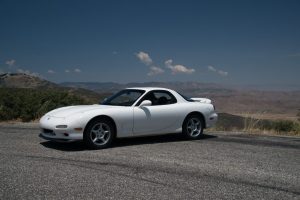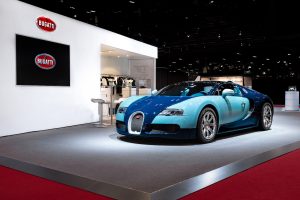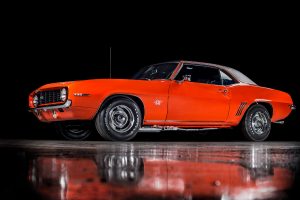Media | Articles
6 cars you might be tempted to fill up while gas is cheap
Before it was the standard fuel for automobiles, in the 1880s, gasoline was a byproduct of lamp oil. In those days gasoline was something to be disposed of, rather than used. Times changed though, and soon this fuel source become one of the world’s most valuable commodities. By the 1960s, economy cars designed with fuel economy in mind became more widespread. When the oil crisis of the early 1970s struck, suddenly companies needed to drastically redesign their cars to meet stringent efficiency and emissions regulations, while also satisfying higher consumer expectations. Cars that were once powerful and fun to drive quickly became either significantly neutered or more expensive.
Now, with the current economic climate bringing oil prices into the negatives for the first time in history, prices at the pump are lower than they’ve been in decades. For those with a gas-guzzler in the garage, bargain-basement fuel prices might seem seriously appealing. So let’s dive into six cars for which, ordinarily, filling the tank (sigh, again) would make us cringe:
1995-1997 Ferrari F50

It comes as no real surprise that a purebred performance machine does not sip gasoline in the same manner its owner sips fancy espresso. Before you mention the lightweight materials like carbon fiber and paint so thin the weave of the carbon can be seen if the light catches the sloping hood just right, remember that a supercar is tuned for maximum performance. The 512-hp, 4.7-liter V-12 doesn’t struggle to hurdle the lightweight package well into the triple digits, and the six-speed manual transmission isn’t exactly geared for efficient commuting at city speeds. All that gives the F50 a typical fuel mileage in the 8 mpg range.
1973-1991 Chevrolet Suburban
If there is one thing that American automakers know well, it is big, lumbering V-8s. In that vein, a 454-cubic-inch engine (combined with the aerodynamics of a poorly-fired brick) makes for a family hauler that needs every bit of a 40-gallon tank to achieve a real-world usable range. The 1974-81 Chevy Suburbans had this massive tank, and I honestly could not imagine using one for transportation during the an era when lines at the pumps and fuel rationing was relatively common. Low double-digit economy means your big-block ‘Burban is running as efficiently as it can. Heaven help you if it’s loaded down.
1978-2002 Mazda RX-7

Even the rotary’s rabid fanbase doesn’t try to hide that fact that the Wankel burns a lot of oil, which makes for undesirable emissions. In fact, most recommend that rotary drivers mix two-stroke oil into the fuel to keep the engine running tip-top. A rotary is technically a four-stroke design, but in this application the term “stroke” takes on a looser meaning; the inner rotor completes the four steps of power production over the course of one rotation, rather than the two of a typical piston engine. The setup makes for an engine that’s happy at high rpm, but there’s simply not a lot of torque output. Rotaries also consume a lot of fuel. The EPA rated the third-generation Mazda RX-7 at just 15 mpg city, which isn’t impressive for a car with only 252 horsepower.
Marketplace
Buy and sell classics with confidence
2005-2015 Bugatti Veyron

The resurgence of the Bugatti brand in 2005 came with the release of the shock-and-awe performance of the Veyron. Packing a massive 8.0-liter, 16-cylinder engine wasn’t enough to propel the new Bugatti into plaid, so the engineers strapped four turbochargers on to pressurize the intake and crank output to 1000 horsepower. All that power requires a lot of cooling. Packed in and around the engine compartment are 10 radiators for various fluids and systems. At its 267-mph top speed, a Veyron Super Sport (1200 hp) will run out of gas in roughly 12 minutes, which is good because its set of tires will only hold up for about 15. EPA city rating—7 mpg.
Dodge Charger Hellcat

Hellcats are known for whining, but typically it comes from the supercharger under the hood rather than the drivers seat. That is, until you reach the fuel pump. That forced-induction V-8 needs fuel to match the inbound air if it hopes to crank out all of that ridiculous 707 hp. Fortunately, the platform is popular enough that maintenance could theoretically be comprised of mostly secondhand parts, saving more for fuel expenses. The Charger Hellcat returns EPA ratings of 12 city/21 highway.
Any muscle car with 3.73 (or numerically higher) gears

The engine is not the only thing that determines fuel economy. Just think of the 427-cube modern Corvettes that pull down low to mid 30 mpg on the highway while still being able to scald a set of rear tires off the line. Yes, C7s have cylinder deactivation, but also consider the role of a fairly tall rear axle ratio and an even taller top gear in the transmission. That makes for low-rpm engine speeds while running down the road. Vintage muscle cars don’t have that luxury of having both acceleration and easily sustained speed—it is often one or the other.
A 3.73 gear ratio means the driveshaft will need to rotate 3.73 times for one axle rotation. With many vintage four-speed transmissions using a 1:1 ratio in fourth, that means the engine is turning some serious speed—especially if you have a short tire diameter. Strap some speed parts and a set of short gears in a muscle car and it is a great Main Street cruiser, but be wary if you want to take it on the highway without confusing the speedometer and the tachometer (if you have one) as your V-8 sounds like it is attempting to sling itself apart at 3000 rpm for hours on end. All the while, it’ll also chug fuel like a sophomore frat boy.
Itching to fill the tank on your ride at these prices? Show us your ride in a comment below.








